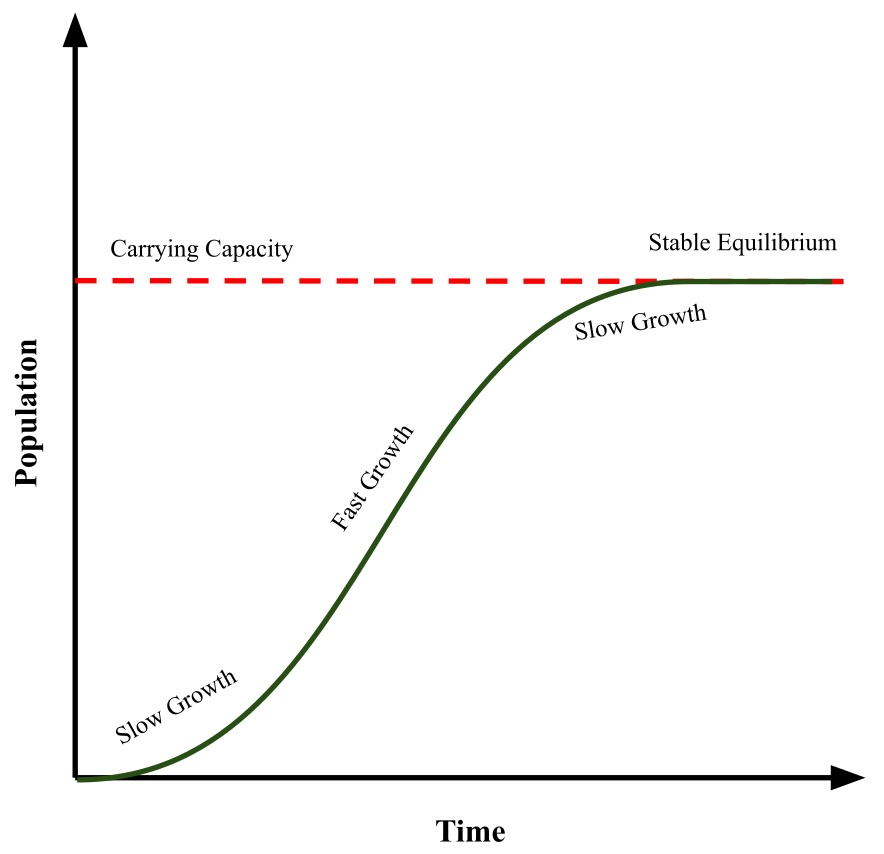By John S. Kim
Startup founders often wonder (and fear) when their growth will slow down and eventually plateau.
Especially in the early days of achieving product-market fit, the hustle and rapid growth often lead founders to overlook certain crucial metrics that ultimately determine the growth limit of the company.
In biology and engineering, there is a concept called “carrying capacity,” which is usually a measure of a terminal value of some capacity, such as population growth or the volume of water in a lake.


For example, in the graph above, assuming steady reproduction and influx of population along with a steady rate of death, the population of a city will initially grow slowly, then go through a period of rapid growth, eventually tapering off around the carrying capacity and reaching a stable equilibrium.
When the influx and outflux are relatively steady, the carrying capacity becomes a fixed number, asymptoting toward a terminal value.
We only need to know two numbers to calculate the terminal value of a system: the absolute influx amount and the percentage of outflux over the same period of time.
 Using this simple formula, we can easily calculate the terminal ARR for your startup.
Using this simple formula, we can easily calculate the terminal ARR for your startup.
So, what is terminal ARR?
Terminal ARR represents the equilibrium point of your annual recurring revenue, where the amount of new ARR added each year equals the ARR lost due to churn and downsell.
It is the maximum revenue your startup is expected to stabilize at, given current growth strategies and customer retention. This metric is important for understanding when your business will reach a revenue plateau and for planning beyond that point.
Calculating terminal ARR: A simple formula
You can calculate terminal ARR using just two numbers: your gross new ARR per year and your gross revenue retention rate. Using your gross revenue retention rate, you can calculate your churn and downsell percentage.
 Using this number, find the terminal ARR by applying the carrying capacity formula.
Using this number, find the terminal ARR by applying the carrying capacity formula.
 EXAMPLE:
EXAMPLE:
Imagine your startup is projecting to add $1 million in new ARR each year, and your revenue retention rate is 90% (or 0.90).

Under current conditions, your business will eventually stabilize at an ARR of $10 million. However, if your retention falls to 80%, your terminal ARR drops to just $5 million.
This is why many investors focus on the revenue retention rate for startups (also known as the “leaky bucket problem”), as the sensitivity to revenue retention is quite high when it comes to calculating your terminal ARR.
Strategic implications
By understanding your terminal ARR and the underlying input metrics — gross new ARR and gross revenue retention — you can set priorities to improve or structurally change the business.
To influence your terminal ARR, you only need to change one of two metrics: gross new ARR or gross revenue retention. This helps you crystallize your priorities.
By focusing on higher-quality customers and deploying rigorous customer retention programs, you can gradually increase your revenue retention. However, given that revenue retention is measured over a year-long period, it will take a good 12 months of lead time for your initiatives to impact the outcome.
Having a long-term view and perseverance to push through your customer retention strategy is key.
Increasing your gross new ARR has more to do with your fundamental value proposition/product, marketing and sales strategies, as well as overall funnel velocity (e.g., sales cycles). Unless you are selling to Fortune 100 or traditional enterprises, it is likely to be shorter than 12 months, so having a robust new and upsell revenue growth strategy can impact the terminal ARR a bit faster.
It’s crucial to continue paying attention to both input metrics to ensure you are maximizing the terminal ARR of your startup. How the combination of gross revenue retention and gross new ARR impacts the Terminal ARR of a company is shown below.
In the example, even with the same gross new ARR, based on the retention, the terminal ARR can have a 4x difference.

As you understand your own business and discover which metric is easier to move, you will have to set your priorities and strategies — all of your product and go-to-market efforts will directly impact these numbers — and your growth potential.
John S. Kim is co-founder and CEO of Sendbird, a communications platform for web and mobile apps. He is also the general partner at Valon Capital, an early-stage venture capital firm focused on B2B, SaaS, AI and deep tech. Earlier in his career, he started Paprika Lab, a social gaming company, which was acquired by Gree.
Illustration: Dom Guzman

Stay up to date with recent funding rounds, acquisitions, and more with the Crunchbase Daily.






![Mar Calendar page being torn off to make way for Apr. [Dom Guman]](https://news.crunchbase.com/wp-content/uploads/mar-apr-2-300x168.jpg)
![Illustration of remote meet on cellphone, unicorn chess piece and money. [Dom Guzman]](https://news.crunchbase.com/wp-content/uploads/business-strategy-300x168.jpg)


67.1K Followers